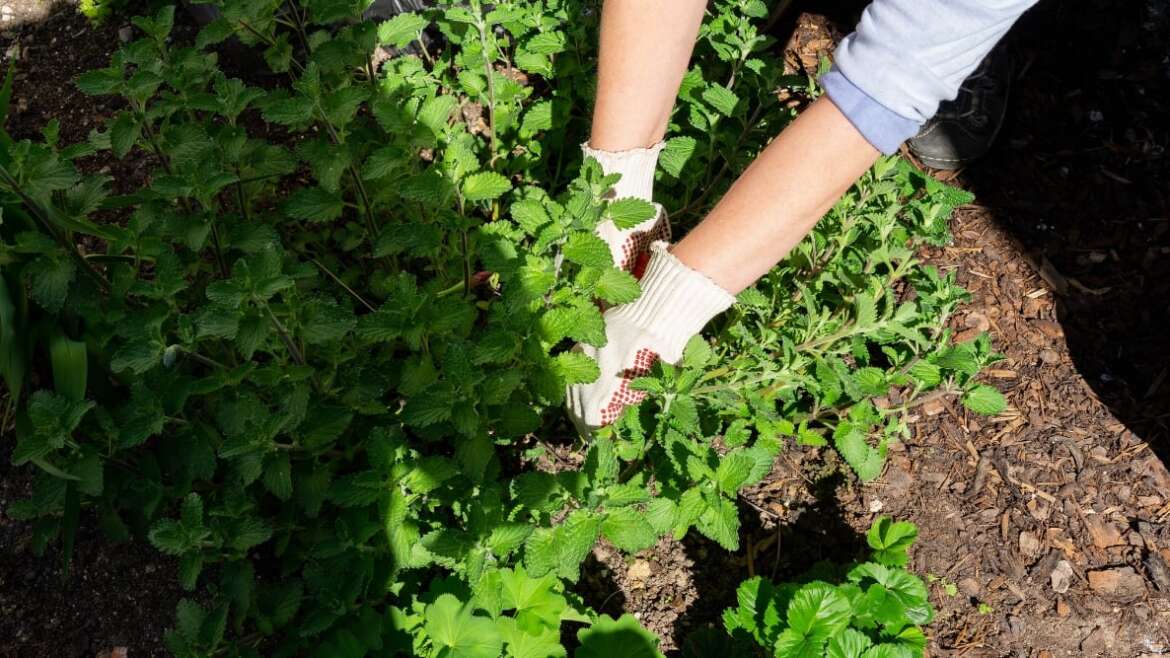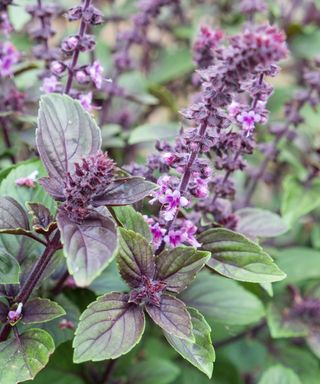Each season, I learn a new tip, trick, or gardening hack that I pack away in my mind and convince myself I’ll remember to try in the coming season. Spoiler alert: I usually don’t. And what a shame because there are so many awesome tricks to help gardeners have fun and create a beautiful, high-yielding garden.
While it may sound like the modern-day version of “The Rachel” haircut, the Chelsea chop is a pruning method for perennials. This can easily be added to your calendar and put on an annual repeat. Then, four to six weeks before your plants bloom, you’ll get a reminder to go out and chop perennial plants that benefit from it.
Let’s talk about this pruning method, when you should do it, and which plants you may already have growing that will benefit from it.
Short Answer
The Chelsea chop is a method for pruning herbaceous plants to control the flowering season and limit the shape and size of the plant. It’s named as such due to the similar timing of the Royal Horticultural Society (RHS) Chelsea Flower Show, a garden design show in London held at the end of May.
Long Answer
Cut back plants for extended bloom and bushier growth.
This method removes about ⅓ of the plant’s height with intentions of delaying its bloom time, encouraging side shoots and a bushier growth habit, and having a more abundant season. It also helps tidy up gardens and prevents plants from becoming unruly.
It’s a more structured and time-sensitive version of pinching back or deadheading plants. Although this requires more work in verdant times of year, your garden will benefit later in the season with a longer bloom season.
Gardeners should habitually do this each season to specific perennials in their garden with a nice pair of pruners or hedging shears, depending on the plants present.
Why Perform The Chelsea Chop?
 Control flowering time to match specific events or to sync with other garden plants.
Control flowering time to match specific events or to sync with other garden plants.
Benefits of performing the chop include:
Perhaps you have a large, unruly plant that’s overshadowing smaller perennials popping up in the spring. This method tidies up the area and ensures all your plants receive the space and sunlight required.
If you simply want to shorten a tall, lanky perennial, prune off the top ⅓ to encourage a bushier plant. Keep perennials from becoming wild and unruly.
Have flowers available for a late-season event such as a wedding or birthday party, or perhaps to avoid “missing the show” if you’re leaving for vacation or to coordinate blooms of other perennials in your garden. Cutting them back will delay their bloom time by about two to three weeks and in this instance, you may choose to chop back the entirety of the patch.
In this case, you may want to select anywhere from 25-50% of the plant and trim the stems down to about ⅓ of their height. This will allow the stems you didn’t cut to bloom as normal, with the others following a few weeks behind, giving you more continuous blooms. The cut stems will also branch out, creating even more opportunities for blooms and a bushier growing habit.
Pruning will encourage a shorter, stockier plant with more side shoots which usually results in a stronger plant. Flowering perennials such as black-eyed Susans and asters are known to get leggy in late summer and can easily flop over. The Chelsea chop should prevent that.
Remember that plants pruned with this technique may produce smaller flowers, but it will provide you with more of them.
There don’t seem to be many issues with performing this pruning method. However, plants that do not react well to this method may not flower for an entire season. I have listed out some perennials that do not respond well later in this article. Stay tuned.
How to do it
 Experimenting with pruning techniques on various patches optimizes plant growth and garden aesthetics.
Experimenting with pruning techniques on various patches optimizes plant growth and garden aesthetics.
There are three ways to perform this method, and which one you choose depends on what goal you have for your plants.
This can be done by simply removing the front or back of a clump or strategically selecting random stems to cut back.
The result of this method will be a longer flowering season, which could be as long as up to four to six additional weeks.
This can be done in one fell swoop by chopping the whole patch, but it can also be done in mini sessions that will result in a staggered harvest. The latter method works with plants that don’t grow uniformly and will continue to bloom all season.
The result of this method creates a shorter and more compact plant. Blooms will be delayed a few weeks but will be more abundant.
If you have more than one area of the same perennial, experiment with performing the chop at different times and levels and record the varied results.
For many growers, chopping seems counterintuitive, especially before the first blooms arrive, especially when their growth is just taking off, and you’re excited that spring has sprung! But I promise, a little bit of work now will result in more productive plants and a more tidy garden. How you prune is a personal preference and depends on your garden’s needs and desires.
Pro tip: After you perform the chop, water your plants well and schedule your fertilizing to happen right afterward to keep them hydrated and boost their productivity.
When to do it
 Perform the chop four to six weeks before your plants bloom or earlier in short seasons.
Perform the chop four to six weeks before your plants bloom or earlier in short seasons.
Since the Chelsea chop is named to coincide with the RHS Chelsea Flower Show in late May, this is typically when gardeners perform the pruning. However, if you have a short growing season, it’s recommended you do this even earlier to take full advantage of the benefits. A good general rule is to chop four to six weeks before your plants bloom.
If your goal is to extend your flowering season, remove the first set up spent blooms immediately after they fade. Otherwise, the plant will go into reproduction mode, and you’ll have lost your chance to encourage that second flush of blooms.
Growers in various growing zones can try performing the chop in early fall rather than in the spring, just before winter dormancy. Trial, error, and learning are half the fun!
Plants that Benefit
 Various plants benefit from this pruning method, enhancing bloom, shape, and pollinator attraction.
Various plants benefit from this pruning method, enhancing bloom, shape, and pollinator attraction.
Different plants benefit for different reasons.
These flowers are very enticing for pollinators. Cutting them back in a staggered fashion keeps them blooming to provide food for bees, butterflies, and hummingbirds.
Aster macrophyllus and Symphyotrichum laeve are encouraged to send out side shoots, become shorter but fuller, and produce more flowers after being chopped.
Chop to encourage more blooms. Some experts recommend snipping only some back to give you more of a staggered second bloom.
Normal bloom time is early summer, but when chopped in late spring, a bushier, more manageable plant develops, and blooms are delayed. More blooms and a longer season mean more pollen and nectar for pollinators.
Echinacea is an important source of food for various wildlife. Chopping encourages more blooms.
After their first big flush and pollinators have had their feed, remove all the spent Foxglove flowers by chopping the stems down to the ground. Foliage continues to look attractive, and hopefully, you’ll get a second set of blooms.
After blooming, the foliage can look tattered. Chopping down spent foliage after its summer bloom encourages a fresh, low-growing mound so it looks fresh again for the rest of the season.
Sneezeweed has a more controlled height and reduces the need for staking.
Reducing the height of what could reach six to ten feet tall is highly beneficial. These are commonly blown over during high wind or rain storms.
Phlox grows into a bushier plant and extends the flowering season.
Black-eyed Susans have a reduced need for staking and send out side shoots for continuous blooms.
Sedum develops more compact plants and doesn’t become top-heavy. Chopping may also encourage more flowers. Cuttings easily root from sedum.
When plants are about a third of their mature height, perform the chop to delay the blooms. Pro tip: if you have wild Goldenrod in your area, harvest from them first, then move on to your delayed patch.
Cutting back just half of Yarrow extends the harvest of this early spring bloomer.
Don’t Chop These!
 This method is ineffective for single-bloom perennials, early bloomers, and wood sub-shrubs, risking bloom loss.
This method is ineffective for single-bloom perennials, early bloomers, and wood sub-shrubs, risking bloom loss.
Flowering perennials that are what I call “one-and-done” don’t benefit from the chop. It’s also not ideal for early bloomers that flower around the time you’ll be performing these chops. If you remove the terminal bud from these, you lose all its blooms for the entire season, so take note of these. This method also doesn’t pair well with wood sub-shrubs.
- Columbine
- Iris
- Lupine
- Papaver (Poppies)
- Peonies: these save up all their energy to bloom just once per season in late spring. Chopping them will cause them harm, and they’ll likely not bloom that season.
- Sunflowers – annual: Although some offer side shoots with shorter stems and smaller blooms, most annual sunflowers are one-cut wonders, and if you chop them, you lose the harvest.
General Tips
- Always use sharp and clean shears or pruners when performing the chop. Clean wounds heal faster and reduce the chance of disease contraction.
- When you’ve selected the stems you want to chop, cut them to about a ⅓ of their original height, similar to pinching back, but not as far down as you’d go when harvesting. Leave several sets of leaves near the base.
- If you decide to chop back a whole patch, leave the plants around the edges a bit shorter to hold up the taller plants in the middle.
- Don’t delay too long, or you may miss the point. The later the chop happens, the later the plants will get a possible second flush of blooms.
- Save the growing tips you’ve chopped off and propagate new softwood cuttings for free, homegrown plants!
- So long as you’ve confirmed plants not to chop, don’t be timid when chopping the ones that benefit. Similar to pinching back snapdragons or basil plants to encourage side shoots and more foliage, this freshens up your plants, encourage more blooming, and signals to the plant that the season is still going strong.
- That said, a common mistake is taking too much, which leads to negative effects. Start with less when you’re trying this method for the first time, and see how your plants react. Then, adjust as needed.
- If you have a particularly dry spring, prune lightly to avoid sending your plants into shock.
- If you prefer the height of a particular perennial, don’t chop it. Instead, stake it.
Final Thoughts
If you haven’t added the Chelsea chop to your 2024 calendar and put it on repeat, what are you waiting for? This method is designed to prolong or extend blooms, tidy up gardens, and reduce the need to stake tall plants and prevent legginess.
Many perennials benefit greatly from this method, so if you have trouble remembering how and when to prune, do so four to six weeks before your plants bloom to the ones you have that perform well after being chopped. Just ensure they aren’t one of the plants listed on the “do not chop” list, and then go for it.




